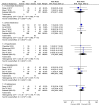Efficacy and Safety of Different Maintenance Doses of Caffeine Citrate for Treatment of Apnea in Premature Infants: A Systematic Review and Meta-Analysis
- PMID: 30671477
- PMCID: PMC6323495
- DOI: 10.1155/2018/9061234
Efficacy and Safety of Different Maintenance Doses of Caffeine Citrate for Treatment of Apnea in Premature Infants: A Systematic Review and Meta-Analysis
Abstract
Background: Caffeine is widely used for the treatment of neonatal apnea, but there is no agreement on the optimum maintenance dose for preterm infants.
Objective: The aims of this meta-analysis were to compare the efficacy and safety of high versus low maintenance doses of caffeine citrate for the treatment of apnea in premature infants.
Methods: Literature searches were conducted using PubMed, Cochrane Library, OVID, Embase, Web of Science, Chinese Biomedical Literature, Weipu Journal, Wanfang, and CNKI databases up to September 2018. Only randomized controlled trials (RCTs) of caffeine citrate for apnea treatment in premature infants were included. Trials were divided into those testing high maintenance doses (10-20 mg/kg daily) and low maintenance doses (5-10 mg/kg daily) for comparison. Data collection and extraction, quality assessment, and data analyses were performed according to the Cochrane standards.
Results: Among the 345 studies initially identified, thirteen RCTs involving 1515 patients were included. Compared to the low-dose group, the high-dose group exhibited greater effective treatment rate (RR: 1.37, 95%CI: 1.18 to 1.60, P<0.0001) and success rate for ventilator removal (RR: 1.74, 95%CI: 1.04 to 2.90, P=0.03), but higher incidence of tachycardia (RR: 2.02, 5%CI: 1.30 to 3.12, P=0.002). The high-dose group also demonstrated lower extubation failure rate (RR: 0.5, 95%CI: 0.35 to 0.71, P=0.0001), frequency of apnea (WMD: -1.55, 95%CI: -2.72 to -0.39, P=0.009), apnea duration (WMD: -4.85, 95%CI: -8.29 to -1.40, P=0.006), and incidence of bronchopulmonary dysplasia (RR: 0.79, 95%CI: 0.68 to 0.91, P=0.002). There were no significant group differences in other adverse events including in-hospital death (P>0.05).
Conclusions: Higher maintenance doses of caffeine citrate appear more effective and safer than low maintenance doses for treatment of premature apnea, despite a higher incidence of tachycardia.
Figures

















Similar articles
-
High versus low-dose caffeine for apnea of prematurity: a randomized controlled trial.Eur J Pediatr. 2015 Jul;174(7):949-56. doi: 10.1007/s00431-015-2494-8. Epub 2015 Feb 3. Eur J Pediatr. 2015. PMID: 25644724 Clinical Trial.
-
Dosing and Safety of Off-label Use of Caffeine Citrate in Premature Infants.J Pediatr. 2019 Aug;211:27-32.e1. doi: 10.1016/j.jpeds.2019.04.028. Epub 2019 May 14. J Pediatr. 2019. PMID: 31101409 Free PMC article.
-
[Clinical effectiveness of different doses of caffeine for primary apnea in preterm infants].Zhonghua Er Ke Za Zhi. 2016 Jan;54(1):33-6. doi: 10.3760/cma.j.issn.0578-1310.2016.01.008. Zhonghua Er Ke Za Zhi. 2016. PMID: 26791921 Clinical Trial. Chinese.
-
Caffeine versus other methylxanthines for the prevention and treatment of apnea in preterm infants.Cochrane Database Syst Rev. 2023 Oct 4;10(10):CD015462. doi: 10.1002/14651858.CD015462.pub2. Cochrane Database Syst Rev. 2023. PMID: 37791592 Free PMC article. Review.
-
Comparative efficacy and safety of caffeine citrate and aminophylline in treating apnea of prematurity: A systematic review and meta-analysis.PLoS One. 2022 Sep 19;17(9):e0274882. doi: 10.1371/journal.pone.0274882. eCollection 2022. PLoS One. 2022. PMID: 36121807 Free PMC article.
Cited by
-
Phosphodiesterase Inhibitors in Acute Lung Injury: What Are the Perspectives?Int J Mol Sci. 2021 Feb 16;22(4):1929. doi: 10.3390/ijms22041929. Int J Mol Sci. 2021. PMID: 33669167 Free PMC article. Review.
-
Caffeine for preterm infants: Fixed standard dose, adjustments for age or high dose?Semin Fetal Neonatal Med. 2020 Dec;25(6):101178. doi: 10.1016/j.siny.2020.101178. Epub 2020 Nov 1. Semin Fetal Neonatal Med. 2020. PMID: 33168464 Free PMC article. Review.
-
Effect of different maintenance doses of caffeine citrate on ventilator weaning in very preterm infants with respiratory distress syndrome: a prospective randomized controlled trial.Zhongguo Dang Dai Er Ke Za Zhi. 2021 Nov 15;23(11):1097-1102. doi: 10.7499/j.issn.1008-8830.2107167. Zhongguo Dang Dai Er Ke Za Zhi. 2021. PMID: 34753540 Free PMC article. Clinical Trial. Chinese, English.
-
Caffeine for the Treatment of Apnea in the Neonatal Intensive Care Unit: A Systematic Overview of Meta-Analyses.Paediatr Drugs. 2020 Aug;22(4):399-408. doi: 10.1007/s40272-020-00404-4. Paediatr Drugs. 2020. PMID: 32488731 Free PMC article.
-
Pulmonary hemorrhage and associated risk factors among newborns admitted to a tertiary level neonatal unit in Botswana.Front Pediatr. 2023 Jun 14;11:1171223. doi: 10.3389/fped.2023.1171223. eCollection 2023. Front Pediatr. 2023. PMID: 37388284 Free PMC article.

